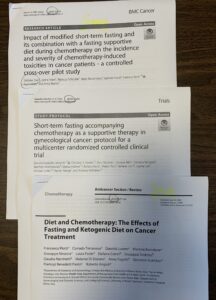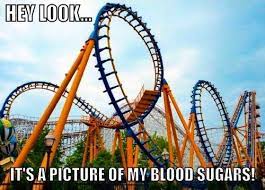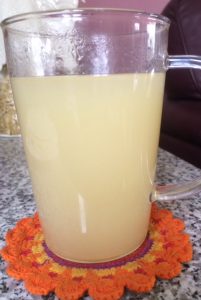Time for some Spring Cleaning!
I have decided it’s time for a changing-of-the-seasons fast. I can’t really tell you why now is the time, but I decided now was the time. It might have something to do with Dr. Al Danenberg’s post about his recent 72 hour fast. https://drdanenberg.com/ketones-72-hour-fast-my-cancer…/ He is a fellow cancer journeyer, a fellow medical professional and Primal Health Coach. He has outlived his terminal diagnosis by over 2 years, thriving on his own unconventional treatment protocol. His blog post about his experience on a recent 72 hour fast tweaked my interest in doing one as well.
As many of you know, I used and recommend a 72 hour fasting period around chemotherapy treatments to limit side effects. The deep ketosis and down-regulation of metabolic cellular processes that it stimulates, are very protective of healthy cells during chemo and very stressful for cancer cells. I did them every three weeks through my chemo, but have only once before done a 3 day fast when not under the influence of chemo drugs. Having medications that makes one feel “under the weather” is actually a plus when fasting, as you don’t feel very hungry. This time was more challenging, as I’m feeling great and so was more likely to get hungry.
While Dr. Al did a water only fast, my fast was supported with coffee, tea and homemade bone broth (defatted for no appreciable calories). The broth has a small amount of protein and lots of good salt. Keeping electrolytes up when fasting is important.
Fasting Disclaimer:
I fasted publicly on Facebook and shared my journey, with additional commentary, as an opportunity for education. I am in no way suggesting that anyone should blindly follow my protocol or example without adequate preparation or without doing due diligence regarding your own personal health situation. If you take any medications, especially anything to do with diabetes or with hypertension, you should NOT be attempting anything more than intermittent fasting (up to 18 hours fasted) without medical support, as blood sugars and blood pressure will normalize very rapidly on a fast and you could experience either low blood sugar or low blood pressure as a result of your meds, both of which mess with your brain and can lead to reduced level of consciousness or falls. Be careful – this is a powerful intervention!
The Stages of Fasting
So what happens to the body during a fast? There’s lots of different “schedules” that are proposed, so this is a generalization, but it’s helpful to have an idea of the stages that the body goes through as it metabolically adjusts to no oral intake.
0-12 hours – You spend the first 3-4 hours after your last meal digesting and metabolizing that meal. Protein, fats and carbs are all broken down in the digestive tract, absorbed into the bloodstream, transported to the liver and then shunted out to the various places that the body determines that it needs to go – build and repair, energy for immediate consumption, or storage glycogen or fat for later.
12-24 hours – Insulin levels in the blood fall in response to no intake. The body responds by switching to using its stored glycogen to meet its glucose needs for the brain and red blood cells (which can’t burn fatty acids). Also, the low insulin levels stimulate the release of stored fats from the fat stores. These are transported to the liver where they are broken down into fatty acids and glycerol.
24-48 hours – Once the glycogen stores are depleted, the body starts making glucose from scratch, a process called gluconeogenesis. It uses protein molecules or glycerol (the backbones of the stored fats) as starting materials. This is where the idea of “burning muscle when starving” came from, but actually, the liver is using protein that has come from the breakdown of old, damaged and junky body parts, a process called autophagy. Old and redundant immune cells, skin cells, collagen and connective tissues, and even entire old cells will be broken down and their parts recycled. This is one reason why those who fast regularly seem to have less trouble with excess skin after large weight losses.
Also after about 24 hours, the liver starts turning fatty acids into ketones. Why? Well, our muscles can burn fatty acids in the mitochondria for energy, fueling our daily activities, but our brains (protected by the blood brain barrier) cannot. It requires a water-soluble fuel. In addition, the red blood cells do not have mitochondria and they require exclusively glucose for fuel. So, in an elegant system, we produce ketones from the fatty acids that are water-soluble and can fuel tissues that would otherwise use glucose. And the truly glucose-dependent tissues are well served by the blood sugars produced by gluconeogenesis. By 4 days into a fast, it’s estimated that about 75% of the brain’s energy needs are being supplied by ketones.
48-72 hours – At about the 48 hour mark, a remarkable thing happens. To preserve protein status and bone density (remember that erroneous concept about the body burning it’s own muscles?), the level of growth hormone will increase up to 5 times its normal level, leading to a maintenance of muscle mass and lean tissues. Also, the level of another hormone, norepinephrine (adrenalin), increases to maintain the basal metabolic rate. This is NOT “starvation mode” with it’s accompanying drop in metabolic rate. In fact, studies have shown that the metabolic rate increases in response to norepinephrine in the presence of fasting, up to 14% after a 4 day fast! The process of autophagy cleanup continues, providing necessary proteins for the gluconeogenesis process. Insulin drops to it’s lowest level, encouraging fat release from the fat stores and increased insulin sensitivity for those who are insulin resistant.
Refeeding after 72 hours – Refeeding results in a reboot of the resting digestive tract and should be started gently. Don’t go from zero (or almost zero) to a full-on feast. Firstly, you won’t be nearly as hungry as you might think. Secondly, you could end up in a big ball of hurt in your abdomen. Once calories and nutrients start flowing again, the body responds by re-building new essential protein structures, particularly the immune system cells. It’s been described as a fresh reboot of the entire immune system. This cellular renewal system is now complete. You have cleaned out the junk (autophagy) and refreshed the parts that were essential. Spring cleaning indeed!
My Fasting Experience
Day 0: I had a delicious satisfying supper – crispy pork-rind-crusted chicken wings (from my local farmer) – and the fast started at about 6:30 in the evening. While cooking the wings, I roasted a chicken carcass and some lamb bones (also from Anita’s farm), ready to go into the Instant Pot after supper to make bone broth (directions in my book, or just google Instant Pot bone broth for ideas). Supper was awesome and I started the fasting period well and truly satisfied.
Day 1: I woke up to a full pot of lovely golden bone broth patiently waiting for me in the Instant Pot. I pressure-cooked my roasted bones and water for 2.5 hours, then let it sit on the “keep warm” function overnight, so it’s perfectly sterile and safe inside its pot. I strained it and ended up with three 750 mls containers of wonderful jiggly, collagen-rich broth. I find that warm salty broth makes a really satisfying meal replacement.
First morning labs: Fasting Blood Sugar (hereafter referred to as FBS) 4.6. Blood ketones 0.4 (already on the edge of full-on ketosis).
Intake Day 1 consisted of about 400 mls organic, black coffee at home, 500 mls coffee at work, followed by 500 mls chicken/lamb bone broth for lunch. Then I was fine until about 3 when I got home from work and had a can of flavoured but unsweetened soda water. Then a cup of peppermint tea. At about 7 pm, I got significantly hunger for the first time all day. But I know from experience that hunger comes in waves – rises up, then recedes. It doesn’t keep building in a linear fashion, thank goodness. I ended up having about 8 oz of bone broth late in the evening, before bed.
Exercise: I went for a 20 minute power walk around my subdivision. That was enough.
Labs: At about 5:45 pm, my random blood sugar (hereafter referred to as RBS) was 4.3 and ketones were up to 1.3 already, well into ketosis.
Day 2: I had a restless sleep, as is usual for me when fasting. But in the morning, I was down 2 lbs on the scale and not at all hungry. To be clear, that’s not fat weight! I had an empty digestive tract and I would lose water because of depleting my glycogen stores, so that’s contributing to the number on the scale being lower. If I had to guess, it might be about a half lb of fat loss (if I’m lucky) and 1 1/2 lbs of water loss and reduced GI contents.
Labs: FBS was lower than usual at 3.8 and ketones were unchanged from yesterday at 1.3.
About noon, as I was finishing the last of my coffee thermos, I started to feel a bit woozy. And hungry. Out if interest, I checked my labs. Holy smokes – what a difference from early in the morning.
Labs at noon: RBS 2.9, Ket 4.8(!)
Normal fasting blood sugar reference range is 3.5-6.0, so that’s way low. But when in ketosis, lower than reference glucose is okay, as the ketones are supplying much of the energy that glucose would normally supply. And my ketone production had really ramped up this morning, propelling me into deep ketosis at 4.8. This would indicate that glycogen stores are well and truly emptied and my insulin levels have dropped quite low, allowing for fat to travel out of storage.
Two hours later, I was feeling much better after a mug of bone broth. So I checked my labs again. Blood sugar had risen marginally to 3.1, still below reference range, and ketones had dropped to 3.7. Amazing how volatile they are in response to internal signals.
Exercise: Another fast walk around the subdivision. That’s 1.4 km, 0.9 miles. At a really fast clip because it was nippy out.
I had peppermint tea for “supper” while sitting with Mike (who ate leftover chicken wings and tossed salad), then herbal chai tea in the evening. I also licked up a bit of Redmonds Real Salt for extra electrolyte support.
Day 3: Well, over the hump… Day 3 and onwards is always better than Day 1 and 2. The body is fully powered by ketones and hunger recedes on Day 3. I slept better than expected, better than I used to when doing this fasting schedule on chemo. Nice surprise. I wasn’t really hungry but black coffee tasted great. I was thirsty.
Day 3 morning labs: FBS 2.6, Ketones 5.0. Holy crap!!! A blood sugar of 2.6 would be a severe hypoglycemic reaction for an insulin dependent diabetic or someone who didn’t have an alternate fuel floating around. But I was fine, truly feeling normal in terms of energy. That would be because of the whopping 5.0 level of ketones. I’ve never achieved a ketone level above 4 before this.
My weight was down another 3 lbs this morning. That’s a total of 5 lbs in 2 days. Again, NOT all fat weight. I had a well and truly empty GI tract now. Any pooping would be comprised of cast-off bacterial bodies from my large bowel, not food residue. I was well-hydrated, but my body wasn’t holding onto as much water without its glycogen stores full. All those things reflect in the scale number.
I felt great. The mental clarity that comes with ketosis was present in spades.
I felt a little floaty all afternoon. When I checked my labs about noon, my RBS was at 2.7 (low) and my ketones were at 5.4 (Holy cow high!). I was a bit concerned, so I went looking for a ketone chart and found the one shown here, that ketones of 5 and above are to be expected with fasting. That was reassuring.
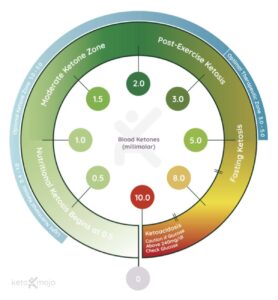
All I needed to get through the afternoon was 125 mls of bone broth and a cup of peppermint tea. About 6, I started supper, making a lovely salad and cooking rice for Mike. Then he took over and pan-fried the salmon. It was delicious, and relatively light on my belly. I am still doing the Whole 30 with no dairy, so I dressed my salad with only olive oil and salt/pepper. It was lovely. I’m stuffed.
At the very end of the fast, I checked my labs once more. RBS 2.4, lowest so far, and Ketones 5.2. It will be interesting to measure them again in a few hours and see what effect that protein- and fat-rich, but almost carb-free meal had on them. I love experimentation!
Post-Fast and the Morning After:
I checked my labs before going to bed (which was stupid early – I was SOOO tired!). It was about 3 hours after my fast-breaking meal of pan-fired salmon with caper sauce and green salad with olive oil. RBS had come up from a super low of 2.4 to a reasonable but still low 4.2. Ketones had dropped from a high of 5.2 pre-supper to 3.9.
I slept for about 9 hours and woke with a sore right hip, likely as a result of laying too long in one position. That’s often an indicator of a really deep sleep. Labs this morning showed FBS 3.0, still flagged as low (reference range is 3.5-6.0), and ketones still well up at 3.8.
My weight in the morning was down another 1.5 lbs, making my total weight change during the fast 6.5 lbs. Again, NOT all fat loss! But I could see a change in my waistline, which was gratifying. Prior to the fast, I had already lost 2 lbs since starting the Whole 30 on April 1. The number on the scale was one that I hadn’t seen since about last October, prior to the “Covid-8” weight gain…
I am returning to my Whole 30 diet plan for the remainder of April. This means no grains, no dairy, no sugars or sweeteners, no alcohol. For me, the big thing is no dairy, as I have a long-standing love affair with cheese. I’m going to continue to check my labs in the next few days to see what my ketones do as I return to “normal” eating, but not several times a day as I have been. And I will be interested to see how much of the weight loss remains after replacing my glycogen stores and refilling my digestive tract with food residue.
In the interest of education and full disclosure, I can report that I did not have a poop on Day 3 of the fasting period. Just not enough bowel contents to make the system move. But on the morning after, I had a small, but soft and perfectly normal BM, not at all constipated. Remember that the definition of constipation is about the texture of stool (hard, dryish, pebbly lumps that are painfully hard to evacuate), not about the timing.
Tips and tricks:
So, here’s what works for me. Everyone is different, but this is my successful pattern:
Morning: Same as non-fasting – about 800-1000 mls organic black coffee (that’s about 33 oz) over about 5 hours from rising to about noon. For comparison, a Tims XL cup is 24 oz, so it’s about 1 1/4 of those.
Afternoon: Likely to have 300-400 ml mug of bone broth with Redmonds Real Salt added. Then later, probably a can of flavoured soda water or maybe a cup of herbal tea. Of course, water ad lib through this whole time.
“Supper”: Make something for Mike and then warm up another cup or so of broth and sit with him. Dinner sitting together at a dining table is a non-negotiable at our house. Followed by a cup of herbal tea during the evening.
Here’s the caloric breakdown of my usual fasting day:
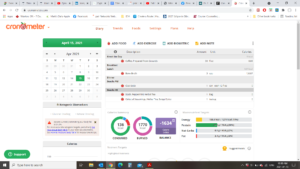
You will see that everything adds up to 136 calories, almost all of which is protein. Nothing else really even registers.
Getting enough electrolytes (sodium and potassium) is important during fasting and really helps to limit the negative feeling that can come with fluctuating blood sugars. Using salt is important, especially a good salt with a variety of minerals such as Redmonds Real Salt or a Celtic or Himalayan salt. Something that’s not pure stark white is usually a good source of a variety of minerals, and they taste great. Even just shaking a bit of salt into your palm and licking it up is often enough to make you feel better.
Staying busy is a real help during the day, This was extra challenging during this fast, as we had an enormous surge in Covid cases in our region and the Public Health office ordered everyone to consider themselves a carrier and stay totally at home for 2 days until contact tracing could catch up. Stores and restaurants were completely shut down. It was serious and we complied. So I needed to find an at-home and indoor (crappy weather) project to keep me occupied. This blog post was part of that strategy.
Monitoring your progress is a great way to get feedback on what’s happening during a fast. I have a glucose/ketone meter, but the ketostix that measure urine ketones are fine for this as well. The disposable sticks that work with the blood meter are stupidly expensive, and I was blowing through about $12 per day during the fast. Although blood monitoring is the gold standard, don’t buy the meter unless you are seriously working towards better metabolic health from a place of unwellness.
If you decide to try 72 hour fasting for your own spring clean, do it carefully, and reap the rewards. It’s hard while you’re doing it, but a wonderful feeling afterwards. And you have shown yourself that you have the self-discipline and power to do something hard but good for yourself – YOU ROCK!

